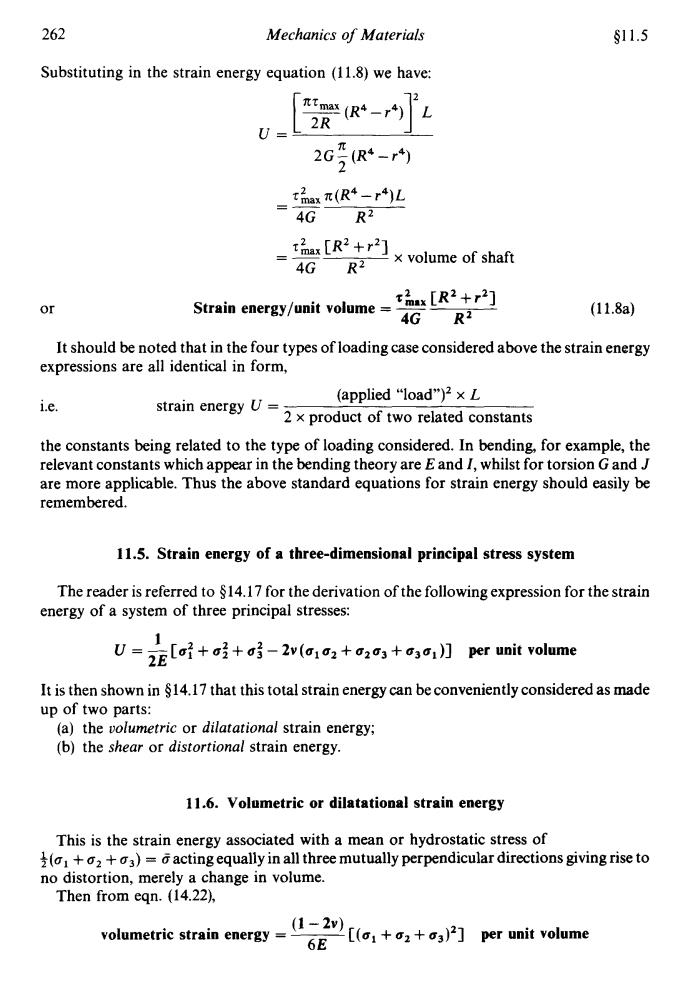正在加载图片...

262 Mechanics of Materials $11.5 Substituting in the strain energy equation(11.8)we have: (R)L 2R U 20a*-r内 txπ(R4-r)L = 4G R2 []x volume of shaft 4G R2 Strain energy/unit volume= tx [R2+r2] or 4G R2 (11.8a) It should be noted that in the four types of loading case considered above the strain energy expressions are all identical in form, (applied“load")2×L i.e. strain energy Uxproduct of two related constants the constants being related to the type of loading considered.In bending,for example,the relevant constants which appear in the bending theory are Eand I,whilst for torsion Gand J are more applicable.Thus the above standard equations for strain energy should easily be remembered. 11.5.Strain energy of a three-dimensional principal stress system The reader is referred to $14.17 for the derivation of the following expression for the strain energy of a system of three principal stresses: 1 V=2E[i+ai+号-2w(a1o+a+o3i】per unit volume It is then shown in $14.17 that this total strain energy can be conveniently considered as made up of two parts: (a)the volumetric or dilatational strain energy; (b)the shear or distortional strain energy. 11.6.Volumetric or dilatational strain energy This is the strain energy associated with a mean or hydrostatic stress of (+2+3)=actingequally in all three mutually perpendicular directions giving rise to no distortion,merely a change in volume. Then from eqn.(14.22), volumetric strain energy-[(1++03)2]per unit volume262 Mechanics of Materials $1 1.5 Substituting in the strain energy equation (1 1.8) we have: [%(R4-r4)] 2 L U= x 2G-(R4-r4) zLx z(R4 - r4)L 4G R2 2 -- tLx [Rz +r2] 4G R2 -- x volume of shaft or zLax [R2 +r2] 4G R2 Strain energy/unit volume = - (11.8a) It should be noted that in the four types of loading case considered above the strain energy expressions are all identical in form, i.e. (applied “load”)’ x L 2 x product of two related constants strain energy U = the constants being related to the type of loading considered. In bending, for example, the relevant constants which appear in the bending theory are E and I, whilst for torsion G and J are more applicable. Thus the above standard equations for strain energy should easily be remembered. 11.5. Strain energy of a three-dimensional principal stress system The reader is referred to $14.17 for the derivation of the following expression for the strain energy of a system of three principal stresses: v=-[ a: + ai + 63 - 2v(ala2 + a263 + a3a1)] per unit volume 1 2E It is then shown in $14.17 that this total strain energycan beconvenientlyconsidered as made up of two parts: (a) the volumetric or dilatational strain energy; (b) the shear or distortional strain energy. 11.6. Volumetric or dilatational strain energy This is the strain energy associated with a mean or hydrostatic stress of $(a, + o2 + os) = 0 acting equally in all three mutually perpendicular directions giving rise to no distortion, merely a change in volume. Then from eqn. (14.22), (1 - 2v) volumetric strain energy = ___ [(al + a2 + a3)’] per unit volume 6E